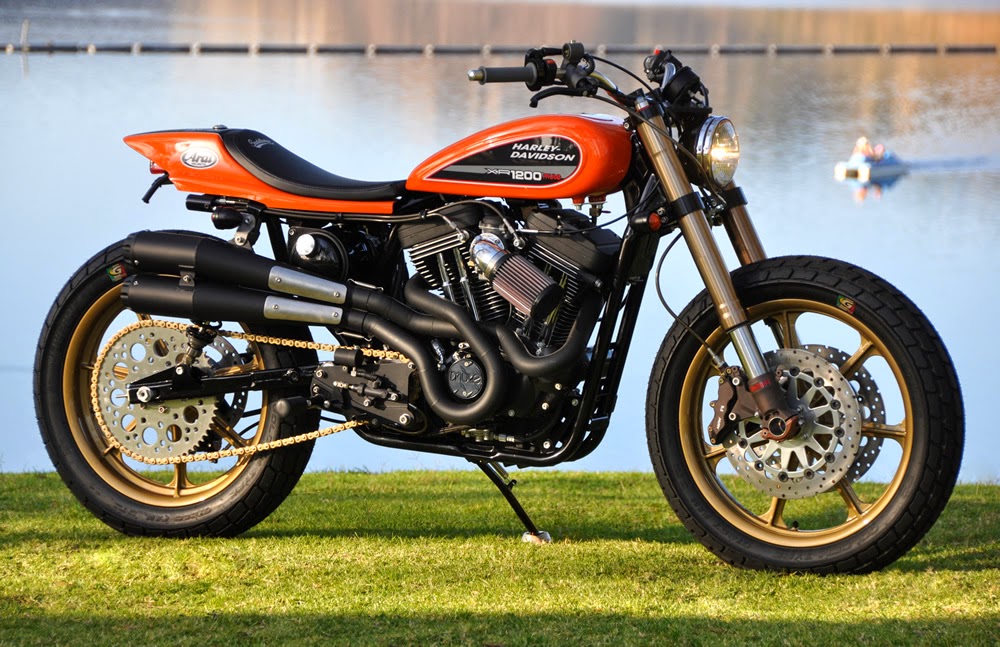
The modern motorcycle has many iterations: bobber, cafe racer, dual sport, cruiser, dirt bike, chopper, etc. But, one of the most fun to ride may well be the street tracker. A street tracker offers the bare-bones look of a flat track racer, yet has the equipment you need to be street legal. These bikes have wide riser bars, good low end power, and most have fiberglass tails, chain-drives, and equally-sized front and rear wheels (typically 19″). They are flickable on the street, fun in the dirt, and ooze with history.
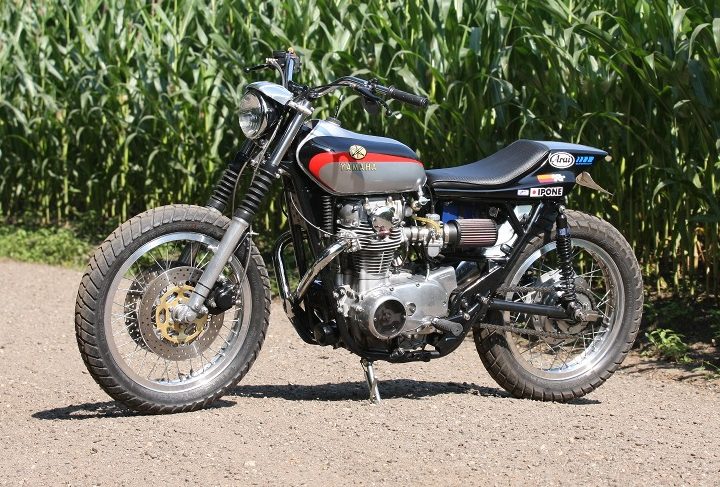
For many, the chance to build their own street tracker is just too enticing to pass up. That said, some bikes lend themselves to tracker builds more readily than others. To that end, we have built a list of the bikes that are most readily converted to street trackers. Before we get to the list, let’s have a look at the history of the street tracker.
Brief History of the Street Tracker
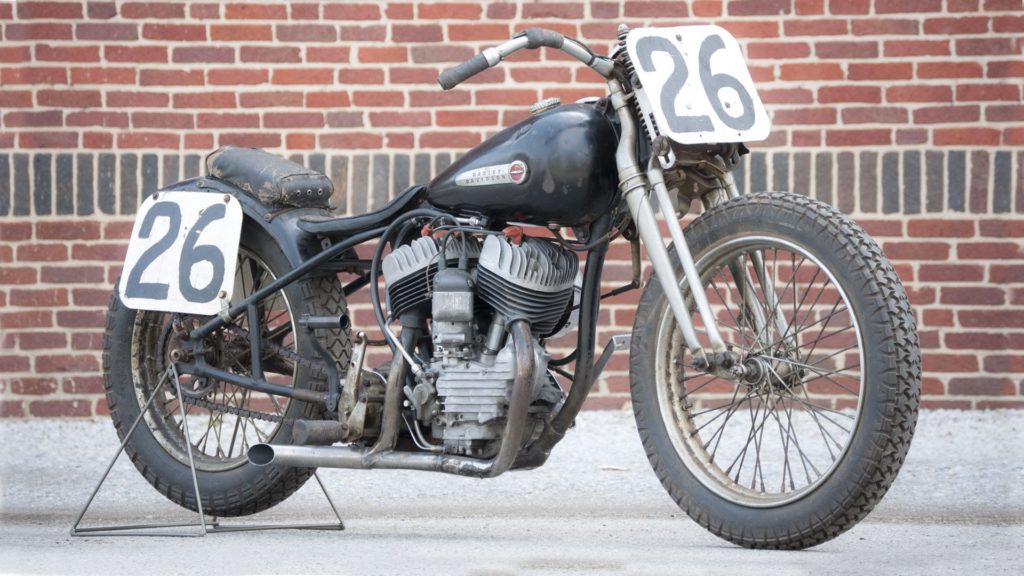
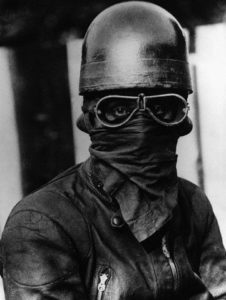
People began racing motorcycles shortly after the Hendee Manufacturing Company introduced the 1.75-horsepower, single-cylinder Indian in 1901. Those early races were spectacularly dangerous for the riders and spectators alike. The Smithsonian Institute even has a great article about the dangers of early motorcycle racing. Most races took place on dirt tracks, and many motorcycle historians still regard flat track as the purest form of motorcycle racing. There’s nothing more elemental than going fast and turning left, your rear wheel sliding sideways in the dirt. All in all, flat track racing has changed little since the days of leather-helmeted men in Indian and Harley-Davidson knit jerseys.
The modern street tracker can trace its roots most directly to the AMA Grand National Championship racing series. The series was extremely popular during the 1960s and 70s. It was the premier motorcycle racing championship, with many of the events taking place on flat tracks. Legends like Dick Mann and Kenny Roberts tore up tracks around the United States, inspiring a generation of riders to take to their local dirt tracks.
There’s that old adage of the car industry: “Win on Sunday, Sell on Monday.” Soon riders wanted to take their track bikes to the streets. In order to do that, they had to modify their flat-trackers to be street legal. That was simple enough: just add lights, mirrors, a horn, and front brakes. Track bikes needed to be ”bump started” at the time, so kick-starts were a nice bonus.
Builders soon came to the fore. One of the best known of these was Mert Lawwill — AMA Grand National Champion and star of On Any Sunday — who produced his own set of XL1200 street trackers.
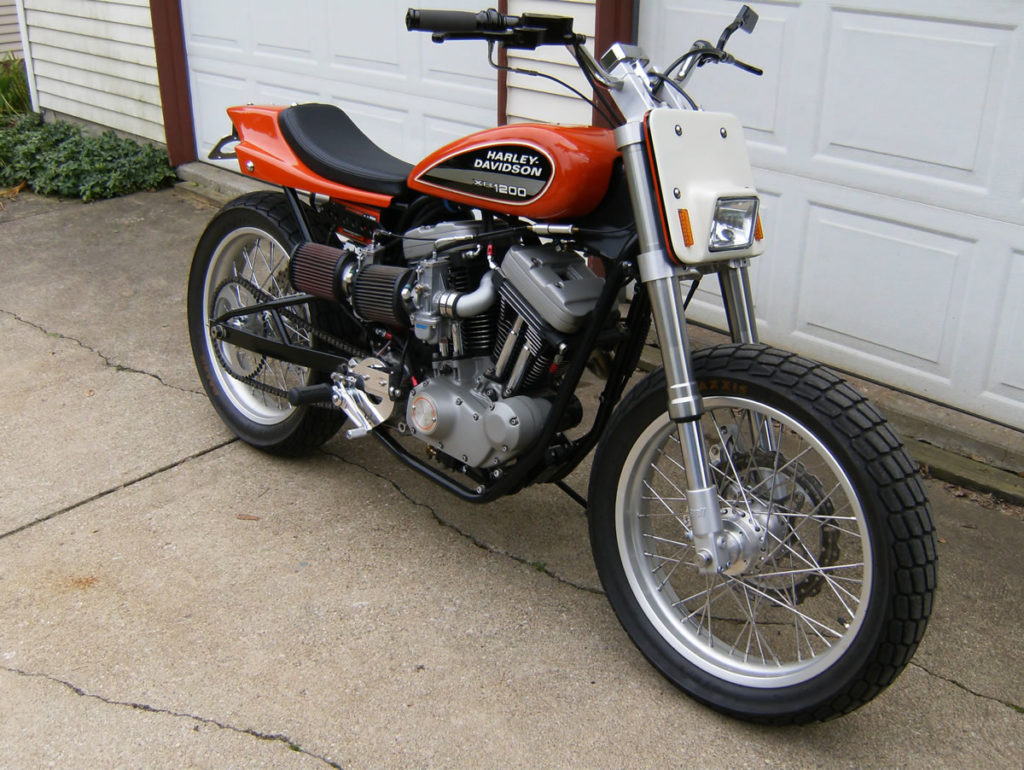
But the undisputed king of the modern street tracker has to be Richard Pollock of Mule Motorcycles, an ex-racer and supreme fabricator who brought the street tracker to a whole new set of riders. For more on the subject, check out our piece: “What is a Street Tracker?”
Street Tracker Design
Just as with cafe racers, bobbers, and choppers, there are certain things that define the street tracker look. Topping the list are the wide handle bars that the early flat track riders used to leverage their rides around turns on the course. You also have to have a small tank like the one that was featured on the Harley Davidson XR750 that many of the AMA series racers based their bikes on. The tank must flow naturally into a slender seat and a minimal rear fender as if it is all one unbroken line. The rear fender should barely cover the taillight, and is usually made of fiberglass. All of this should sit on a pair of 19 inch wheels, often spoked. You can add a front number plate and other racing accouterments if you want to give your new ride the total look of a flat track racer.
Vintage Trackers
With all of that in mind, let’s first look a couple of the purest forms of the flat tracker, which serve as prototypes of the trackers to come.
Harley-Davidson KR750
Why not start with the great-granddad of the modern tracker genre. The Harley-Davidson KR750 dominated the AMA Grand National series for decades. Many could point out that the rules favored flathead engines. The H-D KR750 featured a 741.68 cc V-twin engine and was built specifically for flat track racing. H-D built the KR750 between 1952 and 1969, when better street bikes were readily available, but AMA rules did not allow them on the track.
Finding one today can be a difficult and expensive task. If you do, all you will have to do is add some lights and a license plate. Should you be extremely lucky, you may find one of the few street legal KR-series bikes that Harley built for street riding. If you do some research, you may find that your state allows you to skip the turn signals for a vintage bike, but you will have to brush up on your hand signals.
Harley-Davidson XR750
After scrapping the KR, Harley moved right into the production of the XR750 for the 1970 racing year. Between 1972 and 2008, riders sitting atop XR750s won 29 AMA Grand National Championships. The XR750 was also the preferred bike of legendary stunt rider Evel Knievel. The XR750 and its street racing twin the XRTT750 feature a 748 cc air-cooled V-twin with two 36 mm Mikuni carbs.
Either bike can be converted to become street legal; but, again finding a donor bike is hard and expensive. Luckily, racing fans pestered Harley for a street legal production bike based on the XR750 until H-D gave in, leading us to the next bikes.
Best Bikes for Street Tracker Builds
Harley-Davidson XR1000
The Harley-Davidson XR1000 was HD’s first attempt to market a street legal version of the XR750. It was powered by a 998cc air-cooled OHV V-twin and used the same heads as the XR750. The problem was the sticker price…it was double that of a base XL1000. Harley struggled to sell the bike and it was discontinued after a few model years in the early 1980s. If you find a sample, you can expect to spend around $10,000 for the donor bike and will have to give it a few cosmetic tweaks to create the street tracker look.
Harley-Davidson XR1200
Harley tried again for the 2009 model year by introducing the XR1200 in the North American market. The XR1200 has more of a street tracker look with the slender tank flowing easily through the tank and out the rear fender and taillight. It is powered by H-D’s EVO 1200 engine — rated at 90 horsepower in this configuration — and can quickly be tweaked to have a full street tracker look. With a little online research, you should be able to find a kit that will help you do the job in a single day.

Harley-Davidson Sportster
The entire Harley-Davidson Sportster line can be easily converted to a street tracker. Harley built the XR750 on the Sportster frame to begin with, so converting one is a smallish project. The biggest changes you will need to make are to the handlebars, seat, rear fender, chain drive conversion, and 19″ rear wheel.
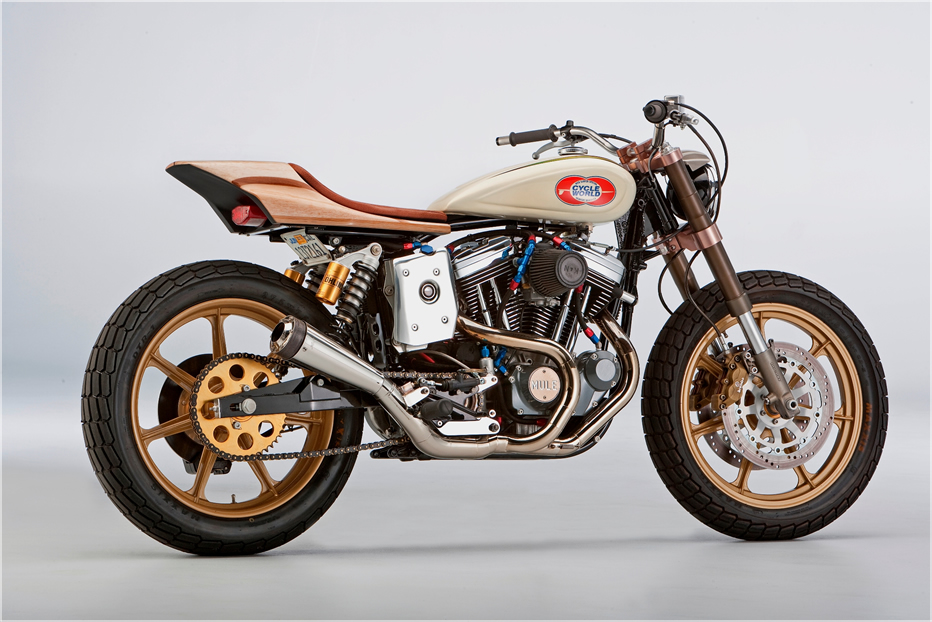
It’s hard to pick any one Sportster out that might be a better fit for a street tracker project. They are all easily suitable to the genre. The pre-1991 solid-mount Sportsters already have chain drives — meaning a chain conversion kit is not necessary — though they have four-speed transmissions instead of the later 5-speed transmissions.

We own a 1989 XLH1200 Sportster — “Blitzen Tracker.” Although the bike is not styled as a traditional street tracker, it has several tracker design cues. We run and highly recommend the Burly Brand Stiletto Shocks (15″), Scrambler Bars, and Bates Baja tires from W&W Cycles.

Other companies to check out for Sportster street tracker builds include Tracker Die and Rusty Butcher Hard Parts.
Yamaha XS650
Easily the most popular bike to use as a donor for a street tracker project is the Yamaha XS650. Many thousands of these bikes were built between 1968 to 1979. That means plenty of donor bikes that should be fairly inexpensive. It also means that there are plenty of spare parts to be found.

The XS650 is powered by an air-cooled SOHC 654 cc, 4-stroke parallel twin. These bikes are not very powerful, but they offer a relatively easy conversion to the street tracker look you want. Omar’s Fiberglass sells a combination seat, fiberglass rear fender, and taillight which we have been using on our very own 1981 XS650 since 2015.
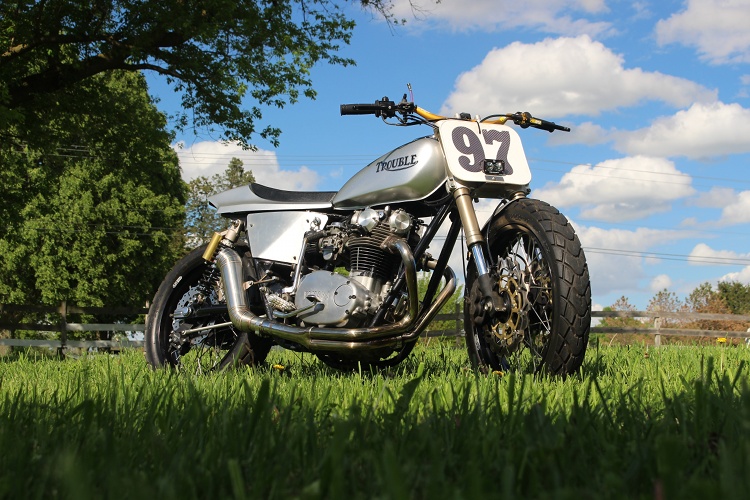
Omar’s also sells a 19″ rear wheel conversion kit, fork guards, front number plates, and various other XS650 street tracker accessories. One of our favorite flat track inspired XS650 builds is the Oval 79 by Ride and Sons, pictured below:
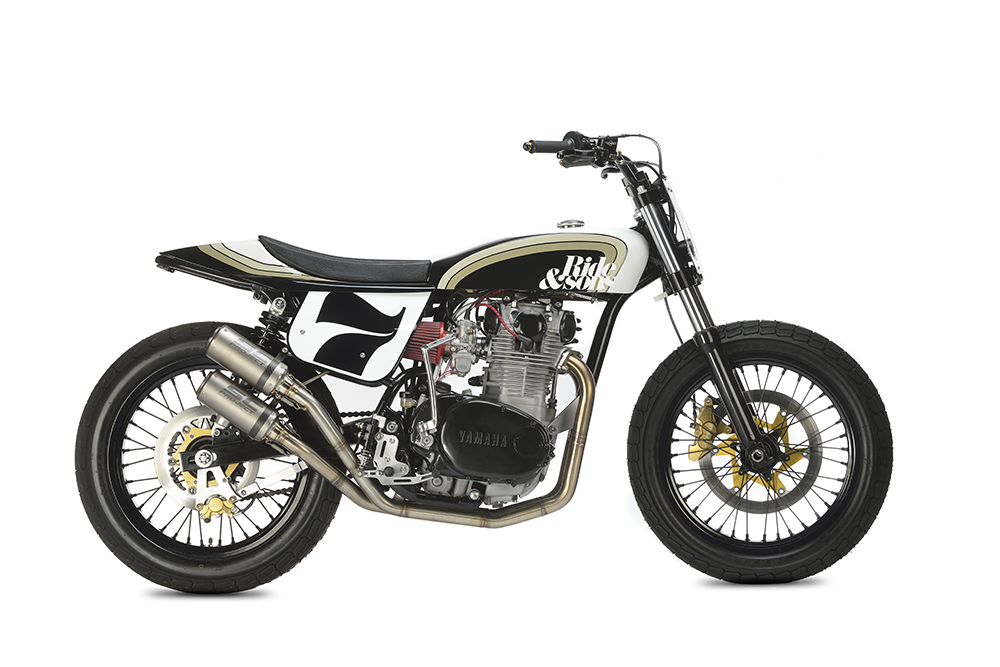
Yamaha SR400/500

Two other Yamaha offerings that can be bent to your will are the SR400 and the SR500. The SR400 is a great project bike because it is still in production. The SR400 wasn’t introduced to North America until 2014, but it has been in production since 1978. The SR400 is a great base bike for street tracker and cafe racer enthusiasts with kits being sold all across the internet for quick conversions to either style of bike. Since the base bikes are still in production, there are plenty of spare parts lying around and the new models are fuel-injected and meet all current emissions standards.
The SR500 was built between 1978 and 1999, but was only sold in North America between 1978 and 1981. Some riders consider the Yamaha SR500 to be one of the most durable motorcycles ever built. As with the SR400, the 500 is easy to convert to a street tracker or cafe racer look and there are plenty of parts and kits to be had. Unlike the SR400, the donor bikes are not going to be cheap.
Suzuki LS650 Savage
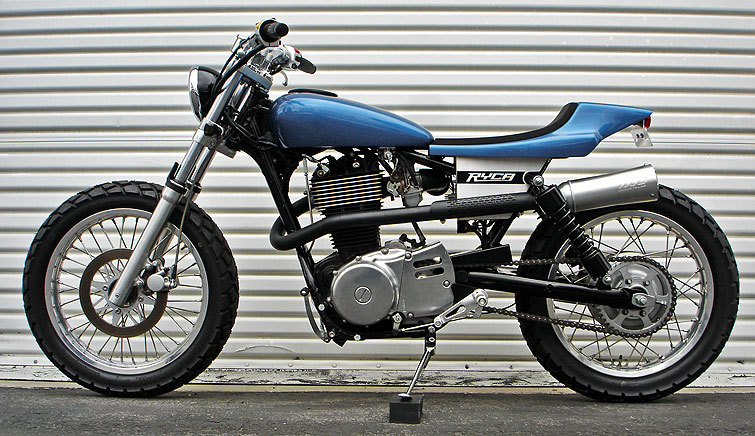
The Suzuki LS650 Savage, now known as the Suzuki Boulevard S40, is an easy convert to the street tracker style. As a bonus it is still in production and is more powerful than the Yamaha offerings listed above. It is powered by a reliable air-cooled, SOHC, 652 cc four-stroke engine with two Mikuni BS40 CV carbs feeding it. One of the biggest bonuses to basing your street tracker on the S40 is the quick kits you can buy. You can jump over to RYCA Motors to see one of the better street tracker kits. We do not get paid for linking to the site…just thought it would be a good resource for you.
Honda XR600 and Honda XR650

The Honda XR series is a group of off-road bikes that are powered by air-cooled single-cylinder four-stroke engines with varying displacements. The two that make the best street tackers are the XR600 and the XR650. Each offers plenty of power, but these bikes — as traditional dual-sports — need a little more extensive work to convert to a classic street tracker look.
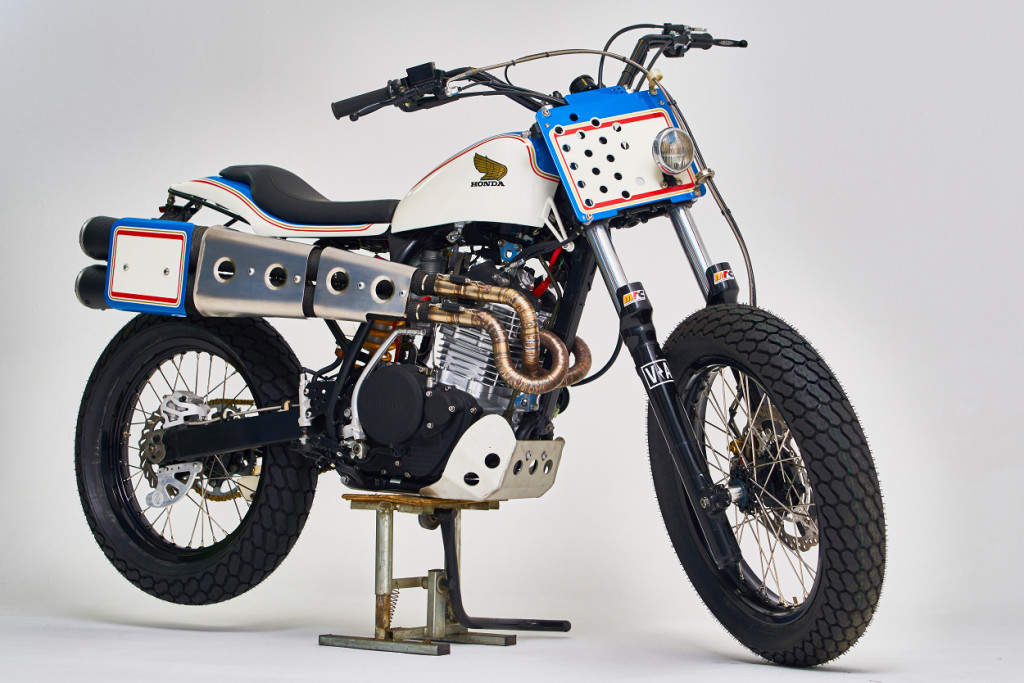
This is especially true of the XR600R, the famed desert racer of the 1990s, which mainly sold as an off-road only model. It will most likely have to be converting into a street-legal bike. This is more easily done in some states and countries than others.

The Honda XR650L, however, has been in production forever, and comes as a street legal machine. Most local classifieds have at least one of these big single stalwarts for sale. While not quite as sexy as the XR600R, these bikes are known to be bulletproof performers, and they have very similar bones for street tracker conversion.
Honda NX650

The Honda NX650 Dominator is one of the most popular bikes to convert to a street tracker. It is known for its superb on and off-road handling and the near legendary durability of its engine. Its 643.7 cc single-cylinder four-stroke engine produces 44 hp. The NX650 Dominator stores its oil within the frame — much like older British bikes.

The downside to the Honda NX650 is that it is so popular among builders, so the donor bikes can get hard to find — especially in the United States, where the NX650 was only available for a couple years. Much like the Honda XR650, these bikes make for their own genre of dual-sport street tracker.
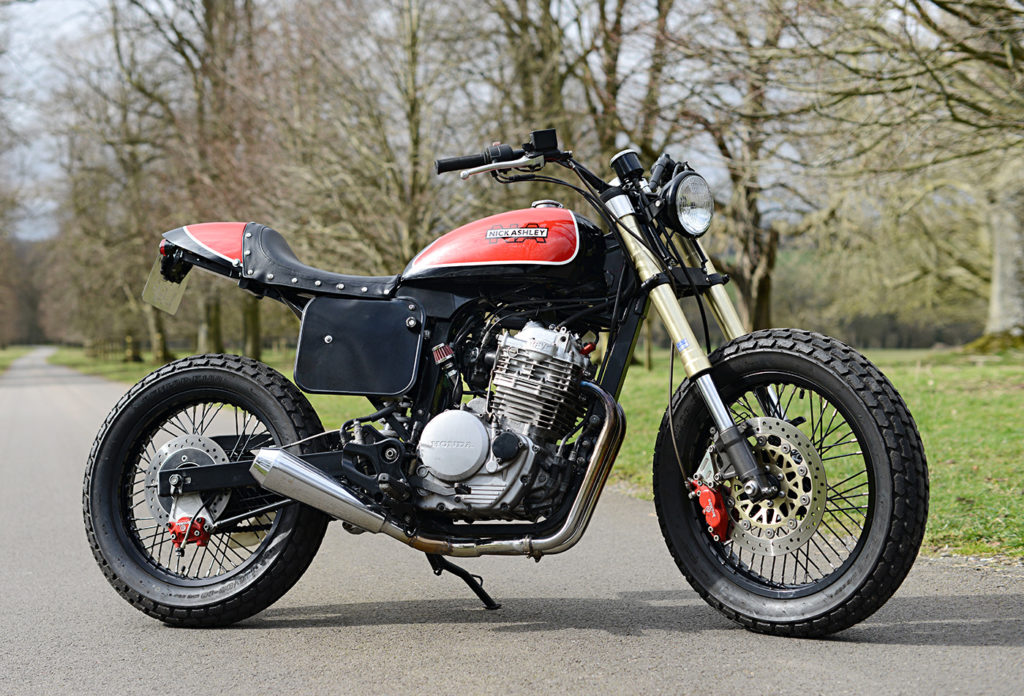
Triumph Bonneville, Thruxton, Street Triple
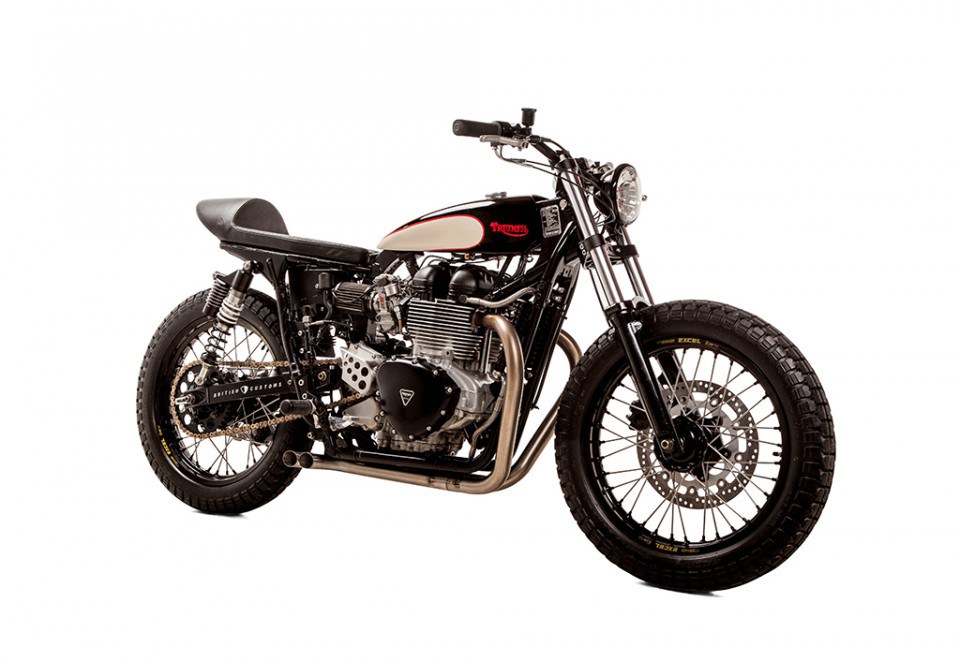
The Triumph line has long been a solid street tracker platform. From the vintage oil-in-frame models of yore to the EFI liquid-cooled twins of today, many models in the Triumph line lend themselves to tracker conversions. For the modern Triumphs — around 2001 and later — the company British Customs makes an entire arsenal of parts, and they have even partnered with the legendary Richard Pollock of Mule Motorcycles for a line of Mule Motorcycle parts.
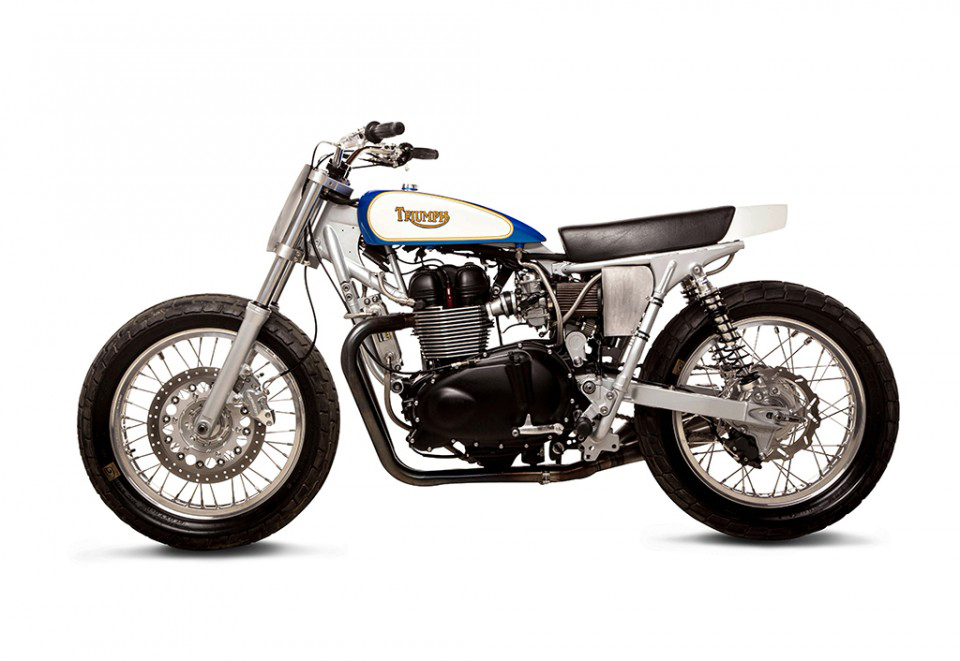
We are also partial to the builds of Bonneville Performance, who run their own “Super Tracker” in American Flat Track and offer a broad array of tracker-oriented performance parts for air-cooled models. You can even buy a fully assembled Bonneville Performance Street Trackers. The team is deep into developing parts for the newer liquid-cooled models.

Other Models
We understand that there are many other bikes that can be converted to a street tracker. We have seen everything from Honda Goldwing street trackers to full-on “framers,” built around custom frames such as this Triumph 650, based on a Redmax C&J replica frame, or Fuller Moto’s Ducati street tracker.
To that end, if you know of a build based on another platform, let us know about it in the comments section. If there are enough pictures, we may even feature it in a future post!







I built my street tracker using a 2002 Suzuki DR650 and I think it makes an excellent donor.
The DR650 has been the same from 1996 through 2017 so OEM parts and a tremendous number of aftermarket parts are available at reasonable prices.
Even an affordable big bore piston & liner to bump displacement to 790cc from ProCycle.
My build thread is on ADVRider.com @
http://advrider.com/index.php?threads/dr650-street-tracker-build.857154/
I have been a Street Tracker guy for years. From WR , KR, XR 750, and XR1000 with an unfinished VR1000 tracker to date. I am in love with the Tin Primary XL Sportster and am at this time setting up my three grandsons to take over the manufactures of traditional XR 750 Frames, Twin Carberated Heads conversion. Tin Primary conversion. and the Pipes ,Tanks, Quick change wheels, forks, and most all high end race worthy build parts for the reconstruction , or recreation of the early Harley Davidson XR 750 Flat Track King for for street or actual race builds. I am thrilled to see the the Trackers taking traction
Good article, although the Suzuki LS650 has a single carburetor; this makes the conversion and setup even easier with this model.
All nice builds but too many Harleys. My latest object of lust is a street tracker based on the Yamaha Mt 07.